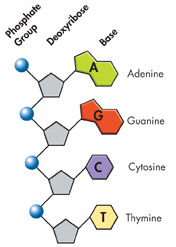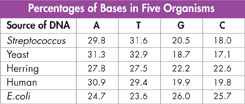If you don't see much in Figure 12–5 that could explain the remarkable properties of DNA, don't be surprised. In the 1940s and early 1950s, the leading biologists in the world thought of DNA as little more than a string of nucleotides. They were baffled, too. The four different nucleotides, like the 26 letters of the alphabet, could be strung together in many different sequences, so it was possible they could carry coded genetic information. However, so could many other molecules, at least in principle. Biologists wondered if there were something more to the structure of DNA.
Solving the Structure of DNA
 What clues helped scientists solve the structure of DNA?
What clues helped scientists solve the structure of DNA?
Knowing that DNA is made from long chains of nucleotides was only the beginning of understanding the structure of this molecule. The next step required an understanding of the way in which those chains are arranged in three dimensions.
Chargaff's Rule One of the puzzling facts about DNA was a curious relationship between its nucleotides. Years earlier, Erwin Chargaff, an Austrian-American biochemist, had discovered that the percentages of adenine [A] and thymine [T] bases are almost equal in any sample of DNA. The same thing is true for the other two nucleotides, guanine [G] and cytosine [C]. The observation that [A] = [T] and [G] = [C] became known as “Chargaff's rule.” Despite the fact that DNA samples from organisms as different as bacteria and humans obeyed this rule, neither Chargaff nor anyone else had the faintest idea why.
 d
dFIGURE 12–5 DNA Nucleotides DNA is made up of nucleotides, each with a deoxyribose molecule, a phosphate group, and a nitrogen-containing base. The four bases are adenine (A), guanine (G), cytosine (C), and thymine (T). Interpret Visuals How are these four nucleotides joined together to form part of a DNA chain?
dAnalyzing Data
Base Percentages
In 1949, Erwin Chargaff discovered that the relative amounts of A and T, and of G and C, are almost always equal. The table shows a portion of the data that Chargaff collected.
Interpret Tables Which organism has the highest percentage of adenine?
Calculate If a species has 35 percent adenine in its DNA, what is the percentage of the other three bases?

Draw Conclusions What did the fact that A and T, and G and C, occurred in equal amounts suggest about the relationship among these bases?

Table of Contents
- Formulas and Equations
- Applying Formulas and Equations
- Mean, Median, and Mode
- Estimation
- Using Measurements in Calculations
- Effects of Measurement Errors
- Accuracy
- Precision
- Comparing Accuracy and Precision
- Significant Figures
- Calculating With Significant Figures
- Scientific Notation
- Calculating With Scientific Notation
- Dimensional Analysis
- Applying Dimensional Analysis





